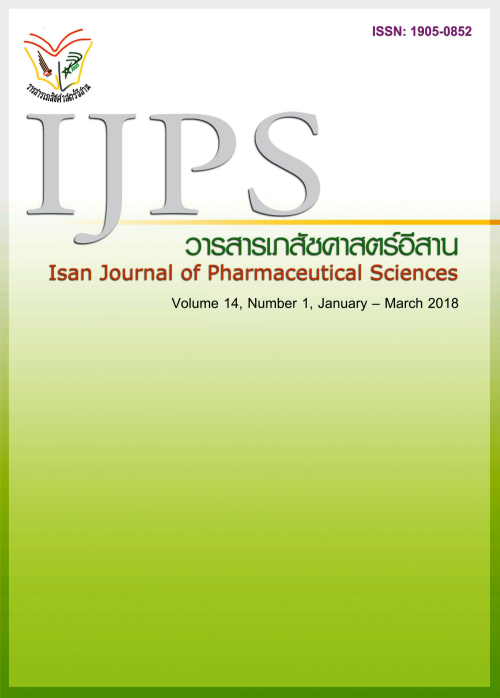One-month effect methoxyflavone-enriched extract of Kaempferia parviflora on blood glucose and lipid profile in rats
Main Article Content
Abstract
Kaempferia parviflora is a medicinal plant that popular consuming and widely used for attenuating human health problem in Asia. The major phytochemical ingredients of K. parviflora extract are methoxyflavones. This study aimed to investigate one-month effect methoxyflavone-enriched extract of Kaempferia parviflora (KDE) on blood glucose and lipid profile in rats. The animals were randomly divided into 4 groups which were orally administered with distilled water (normal control), carboxy methyl cellulose (normal vehicle), KDE at doses of 150 and 300 mg/kg/day for 4 weeks. The results demonstrated that rats receiving KDE 300 mg/kg had significantly lower blood glucose level than normal control and normal vehicle groups (p<0.05). Both KDE150- and 300-treated rats tended to decrease the cholesterol and triglyceride levels. Level of atherogenic index in KDE300-treated rats was significantly lower than normal vehicle group. Additionally, alteration of body weight and the damaged of histological structure of liver, kidney and pancreas were not observed as compared to normal and vehicle control groups. The results suggest the safe dose and promoting health benefit in short-term administration of KDE.
Article Details
In the case that some parts are used by others The author must Confirm that obtaining permission to use some of the original authors. And must attach evidence That the permission has been included
References
Akase T, Shimada T, Terabayashi S, et al. Antiobesity effects of Kaempferia parviflora in spontaneously obese type II diabetic mice. J Nat Med 2011; 65(1):73-80.
Azuma T, Kayano S.-i., Matsumura Y, et al. Antimutagenic and α-glucosidase inhibitory effects of constituents from Kaempferia parviflora. Food chem 2011; 125(2):471-475.
Azuma T, Tanaka Y, Kikuzaki H. Phenolic glycosides from Kaempferia parviflora. Phytochemistry 2008; 69(15):2743-2748.
Berdanier CD. Gastrointestinal system and metabolism. In: Hedrich HJ and Bullock G, editors. The handbook of experimental animals: the laboratory mouse. Elsevier, San Diego; 2004. 245-259.
Chivapat S, Chavalittumrong P, Attawish A, Rungsipipat A. Chronic toxicity study of Kaempferia parviflora Wall ex. extract. Thai J Vet Med 2010; 40(4):377-383.
evaluation of crude drugs and volatile oil of Krachai-dam rhizomes. The Bulletin of The Department of
Fischer AH, Jacobson KA, Rose J, Zeller R. Hematoxylin and eosin staining of tissue and cell sections. Cold Spring Harb Protoc 2008; 2008(5):pdb. prot4986.
Gillies PJ, Rathgeb KA, Perri MA, Robinson CS. Regulation of acyl-CoA: cholesterol acyltransferase activity in normal and atherosclerotic rabbit aortas: role of a cholesterol substrate pool. Exp Mol Pathol 1986; 44(3):329-339.
Hartree EF. Determination of protein: a modification of the Lowry method that gives a linear photometric response. Anal Biochem 1972; 48(2):422-427.
Lafontan M, Langin D. Lipolysis and lipid mobilization in human adipose tissue. Prog Lipid Res 2009; 48(5):275-297.
Leardkamolkarn V, Tiamyuyen S, Sripanidkulchai B. Pharmacological activity of Kaempferia parviflora extract against human bile duct cancer cell lines. Asian Pac J Cancer Prev 2009; 10:695-8.
Malakul W, Ingkaninan K, Sawasdee P, Woodman OL. The ethanolic extract of Kaempferia parviflora reduces ischaemic injury in rat isolated hearts. J Ethnopharmacol 2011; 137(1):184-91.
Medical Sciences 2003; 45.
Mekjaruskul C, Jay M, Sripanidkulchai B. Pharmacokinetics, bioavailability, tissue distribution, excretion, and metabolite identification of methoxyflavones in Kaempferia parviflora extract in rats. Drug Metab Dispos 2012; 40(12): 2342-2353.
Mekjaruskul C, Yang Y-T, Leed MG, Sadgrove MP, Jay M, Sripanidkulchai B. Novel formulation strategies for enhancing oral delivery of methoxyflavones in Kaempferia parviflora by SMEDDS or complexation with 2-hydroxypropyl-β-cyclodextrin. Int J Pharm 2013; 445(1):1-11.
Moon H, Kim D, Kim S, Seo S. Effect of 6-hydroxy-7, 4’-dimethoxyflavone on antidiabetic effects in normal and streptozotocin-induced diabetic rats. Bulg Chem Commun 2016; 48(2), 317-322.
Murata K, Deguchi T, Fujita T, Matsuda H. Improvement in blood fluidity by Kaempferia parviflora rhizome. J Nat Med 2013; 67(4):719-724.
Ohkawa H, Ohishi N, Yagi K. Assay for lipid peroxides in animal tissues by thiobarbituric acid reaction. Anal Biochem 1979; 95(2):351-358.
Okabe Y, Shimada T, Horikawa T, et al. Suppression of adipocyte hypertrophy by polymethoxyflavonoids isolated from Kaempferia parviflora. Phytomedicine 2014; 21(6):800-6.
Park JE, Pyun HB, Woo SW, Jeong JH, Hwang JK. The protective effect of Kaempferia parviflora extract on UVB-induced skin photoaging in hairless mice. Photodermatol Photoimmunol Photomed 2014; 30(5), 237-245.
Rujjanawate C, Kanjanapothi D, Amornlerdpison D, et al. Anti-gastric ulcer effect of Kaempferia parviflora. J Ethnopharmacol 2005; 102(1):120-122.
Sae-wong C, Tansakul P, Tewtrakul S. Anti-inflammatory mechanism of Kaempferia parviflora in murine macrophage cells (RAW 264.7) and in experimental animals. J Ethnopharmacol 2009; 124(3):576-580.
Somintara S, Sripanidkulchai B, Pariwatthanakun C, Sripanidkulchai K. Hypolipidemic effect of methoxyflavone-enriched extract of Kaempferia parviflora in cholesterol-induced dyslipidemic rats. Songklanakarin J Sci Technol. (In press).
Tewtrakul S, Subhadhirasakul S, Kummee S. Anti-allergic activity of compounds from Kaempferia parviflora. J Ethnopharmacol 2008; 116(1):191-193.
Thao NP, Luyen BTT, Lee SH, Jang HD, Kim YH. Anti-osteoporotic and Antioxidant Activities by Rhizomes of Kaempferia parviflora Wall. ex Baker. Nat Prod Sci 2016; 22(1): 13-19.
Vichitphan S. Flavonoid content and antioxidant activity of KRACHAI-DUM (Kaempferia parviflora) wine. Songklanakarin J Sci Technol 2007;7(2-1).
Wang Z, Yang Y, Xiang X, Zhu Y, Men J, He M. Estimation of the normal range of blood glucose in rats. Wei sheng yan jiu= Journal of hygiene research. 2010; 39(2):133-137, 142.
Wattanathorn J, Muchimapura S, Tong-Un T, Saenghong N, Thukhum-Mee W, Sripanidkulchai B. Positive modulation effect of 8-week consumption of Kaempferia parviflora on health-related physical fitness and oxidative status in healthy elderly volunteers. Evid Based Complement Alternat Med 2012; 2012.
Wongsinkongman P, Mongkolchaipak N, Chansuvanich N, Techadumrongsin Y, Boonruad T. Quality
Wungsintaweekul J, Sitthithaworn W, Putalun W, Pfeifhoffer HW, Brantner A. Antimicrobial, antioxidant activities and chemical composition of selected Thai spices. Songklanakarin J Sci Technol 2010; 32(6):589.


